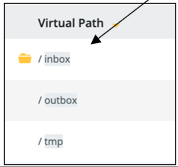Client Connection: PR5S
Fields with the asterisk * are mandatory.
| Properties | Description |
|---|---|
| NAME * | Name of the PR5S connection you are creating. The maximum number of characters is 128. Blanks and these special characters: ' " | are not supported. |
| DESCRIPTION | Description of the PR5S connection you are creating. The maximum number of characters is 2048. |
| STATUS | Enable or disable the client connection. Possible values: |
| HOST * | Remote host IP Address or hostname. |
| PORT * | Port to connect to the remote host (1 to 65535). |
| USERNAME | Username to be used for the connection. The maximum number of characters is 320. |
| PASSWORD | User password. |
| CONNECTION TIMEOUT * | Number of seconds without network activity to wait before closing a session due to inactivity. Default value: 60. |
| CONNECT THROUGH DMZ | Enable or disable DMZ proxy. Possible values: |
| QMANAGER NAME | Name of the remote Queue Manager. |
| CLIENT KEY LABEL | Key identifier to create the SSL connection |
| SSL AUTHENTICATION PROTOCOL | Select the SSL authentication protocol:
|
| ACCEPTED CIPHER SUITES | Select the cipher suites. ALL or specific values in the drop-down list (See ACCEPTED CIPHER SUITES): |
| SIZE OF SYNC POINT WINDOW | This value is in bytes and sets when the client and the server must synchronize during the file transfer. This synchronization is important for the restart. The default is 10240000 bytes. |
| LOCAL QM * | Name of the first local directory in the Virtual Path. It can be found in Actor → Edit → VFS tab → Edit VFS: |
| INTERNAL CONNECTION | This parameter sends additional information to the PR5 client connection. The parameter must be set only if the client connection addresses an internal peer in the same Data One instance, i.e. the client connection is used to exchange files between clusters on the same installation. The purpose of this parameter is to propagate the Dataflow Instance Id (DFIC) of the master transport to the server transport during the file transfer operation (otherwise this information is not propagated). With this parameter, the master transport and the server transport share the same dataflow instance id value and DATA WATCHER can match the two master and slave transfers to the same flow. |
| MATCH SERVER HOSTNAME | Possible values: When set to Enabled, the Client verifies that the Distinguished Name (DN) certificate contains the IP that has been contacted (i.e., the HOST value above). |
| MAX RETRIES | Maximum number of retries. If this field is empty or set to 0, no retries will be executed and the job will be set to Failed if the first attempt is not successful. A high value corresponds to a high number of retrying attempts. |
| RETRY INTERVAL | This field will appear only if you have set the maximum numbers of retries to 1 or greater. Time (in seconds) waited before retrying executing a job. The lower the value, the more frequent the retrying attempts. If this field is empty or set to 0, no retries will be executed and the job will be set to Failed if the first attempt is not successful. |
| CONFIGURATION TEST | Use this section to test that the Cluster and the STENG are connected correctly. Select a Cluster and a STENG you want to test and click the TEST button. Data One automatically selects a Cluster and a STENG to test the connection. Note that a Cluster will be selected only if it is the only one available. A message with a green check will confirm a successful connection. A message with a red exclamation mark will warn about an unsuccessful connection. The message also details the reason why the connection fails. The connection might not be successful for different reasons, each of them depending on the transport type and the configuration. The first time you try to test the connection, if trusting certificates are missing, an error message detailing the unsuccessful connection will appear. In this case, go to Setup → Untrusted Cache → Certificates tab and trust the relevant certificates. Note that trusting certificates in the Untrusted Cache page may not be sufficient to establish a successful connection. Refer to the Untrusted Cache section of this guide for all the details. |
Updated about 1 year ago
